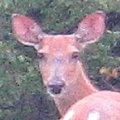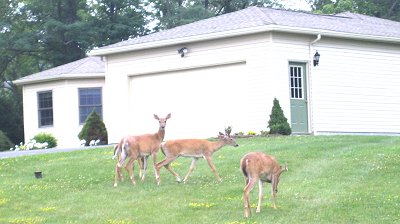- By Dan Veaner
- News
 Print
Print  With Village of Lansing properties being stripped bare by grazing deer, Trustees have struggled with making their deer population control program effective. Trustee Lynn Leopold reported on this year's hunt at Monday's regular meeting at the Village of Lansing Office. Controlled hunts sanctioned by the Village using New York State Department of Environmental Conservation (DEC) Deer Assistance Program (DMAP) tags yielded 33 deer on three properties. Another 30 or so deer are killed in automobile accidents each year. But Leopold says that may not be enough to save the Village's forested lands.
With Village of Lansing properties being stripped bare by grazing deer, Trustees have struggled with making their deer population control program effective. Trustee Lynn Leopold reported on this year's hunt at Monday's regular meeting at the Village of Lansing Office. Controlled hunts sanctioned by the Village using New York State Department of Environmental Conservation (DEC) Deer Assistance Program (DMAP) tags yielded 33 deer on three properties. Another 30 or so deer are killed in automobile accidents each year. But Leopold says that may not be enough to save the Village's forested lands."It's not about tulips, folks," Leopold told the board. "It's about forest reproduction and a whole lot of other things."
Village Trustees instituted a deer population control program in October of 2007 when they amended its Code-Firearm and Bow Safety Law. The amendment brought Village law in line with DEC regulations and extended bow and firearm hunting restrictions to encompass the entire Village. That opened the way for private landowners to request DMAP tags of the Village if their property meets the requirements of the program and State law.
That land requirement is part of the problem. There are only a handful of properties in the Village that are large enough to meet the rule that says you may not shoot within 500 feet of a dwelling or public structure. The largest qualifying property in the Village is Sundowns Farm, which borders Triphammer Road north of the shopping district. But Village officials have been unable to persuade the owner to allow a hunt there.
Of the 33 deer taken out in this year's hunts, 18 were on DMAP tags. Because of the limit on the number of tags one hunter can have it is difficult to get enough hunters to make a greater impact on the deer population. And while most Village residents acknowledge the devastation deer have wrought, not all want hunting on their property. That can mean that if a deer is wounded and wanders onto another property, the hunter may not retrieve the animal. Another problem is that deer don't stay in one place. Leopold says she saw four deer with collars that may have been put on the animals as part of Cayuga Heights' deer population program. The Village of Lansing does not collar deer.
This year's hunt was successful in removing about 10% of the Village's deer population, but officials say the area is still dangerously overpopulated. Leopold worries that old growth forest land will not be renewed because the animals are decimating all the new growth.
"It's an ongoing difficulty because the State wants to manage the maximum number of deer for hunters, because they really need that income," she said Monday. "But because they are the Department of Environmental Conservation they also have to think about what too many deer are doing on an ecosystem-wide basis. It's pretty severe."

Deer grazing in a Village of Lansing yard
She urged Trustees to reevaluate the program to find ways to make it more effective. Over the past three or four years Trustees have considered a number of options including sterilization and allowing DEC sharpshooters to kill deer. Village law forbids firearm fire anwhere whithin the municipality's boundaries. The only option they found viable was controlled bow hunts. The DEC provides the Village with a number of DMAP tags. If a landowner has invited a hunter to participate that hunter can be given two DMAP tags in addition to their regular hunting tags. But the DMAP tags only allow them antlerless deer.
"It's a lot of time for a lot of hunters just sitting and not getting anything, because the bucks are walking past them and they can't shoot them," Leopold said. "They don't have the right tags. DMAP tags are only for antlerless deer, and they may want to save their other tags for other places."
Cornell University approached the Village last fall to get permission for their bow hunters to kill deer on Cornell land within the Village boundaries. Cornell has had escalating deer problems that have impacted the Cornell Plantation, campus and other university-owned lands. Leopold says that many does have triplets, and this year's hunt may have prevented between 30 to 60 fewer fauns being born next Spring, a considerable dent in a Village population that is estimated to be between 200 and 300 animals.
Deer population control is important not only because it saves forests and gardens, but also because when herds become too large there is not enough food to sustain them. That results in disease and animals dying of starvation, and more plant damage as the deer eat away plants they otherwise wouldn't have liked to eat. Leopold said the Trustees should consider adding nuisance tags to the mix, which are not limited to hunting season and allow for killing male and female deer.
But she warned that the Trustees should consider that option carefully because of the impact it could have on other aspects of Village life. She says that the deer program has worked for three years, but it is still not effective enough to make a meaningful difference.
"We've been at this for years now, and I think it's time to reevaluate it and think it through," she said.
----
v6i1



